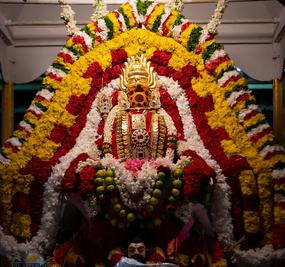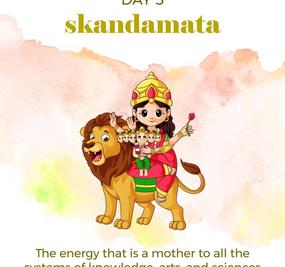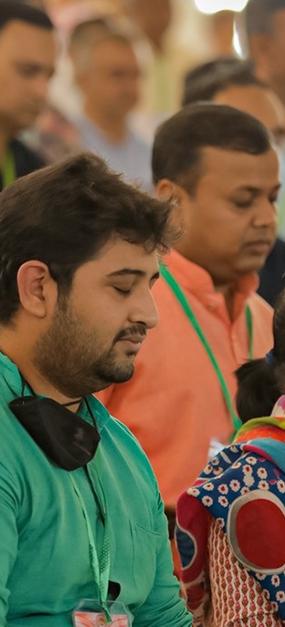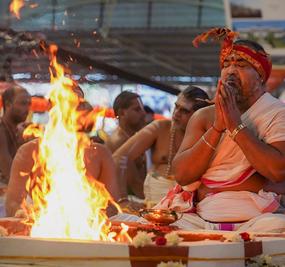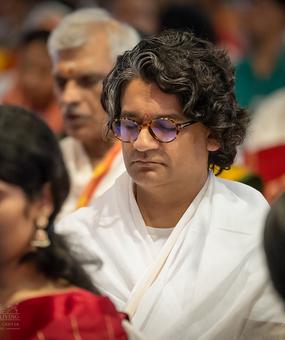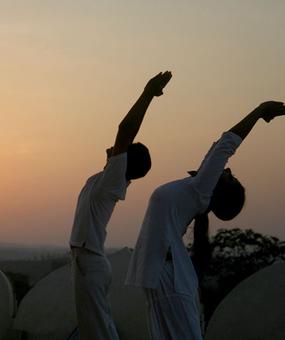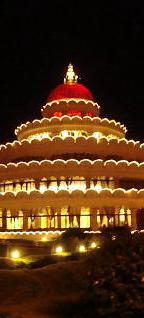On the seventh day of Navratri, Mother Divine takes the form of Kaalaratri. She is one of the most ferocious and destructive forms of Durga Devi.
Navratri falls between October 3rd to October 12th in 2024.
Kaala means ‘time’ as well as ‘black’, and ratri means ‘night’. The Devi is worshipped as the destroyer of ignorance and remover of sorrow.
Form of Kaalaratri Devi
Kaalaratri has a dark complexion akin to night. Her bountiful hair is untied. She has four hands – two of them wield weapons – a scimitar and a thunderbolt. The other two are in varada or blessing mudra and abhaya or protecting mudra. She wears a necklace that shines like the moon illuminating the night.
She has three eyes from which emanate rays like lightning, displaying her fury in full. She emits flames from her nostrils as she breathes.
She rides a black donkey.
What the Devi Represents
This form of the Devi depicts the dark and violent side of life. Appearing in one of her fiercest and most terrorizing forms, She evokes fear. She uses this form to destroy evil powers like negativity, cruelty and ignorance.
Devotees pray to her to dispel darkness, ignorance, and sorrow from their lives. She is also known as Shubhankari, as she ensures that good deeds of her devotees bear fruit. She also protects them from harm and danger.
Legends Behind Why Devi Took the Form of Kaalaratri
One legend behind the Devi assuming the form of Kaalaratri says that it was to destroy two demons Shumbha and Nishumbha. These two demons had wreaked havoc in devaloka, the abode of the lord of the devas (gods), Indra. Indra and the other gods went to the Himalayas entreating Lord Shiva to help them retrieve their home. Lord Shiva requested Goddess Parvati to help get rid of the two demons.
As Parvati was busy with her ablutions, she created Chandi Devi to destroy the demons. Shumbha and Nishumbha, in turn, sent two generals, Chanda and Munda, to counter Devi. Chandi created Kaalaratri Devi, who killed both these demon generals, and, consequently, earned the name Chamunda.
Another demon, Raktabeej, was sent to kill the Devi. Rakta means ‘blood’ and beej means ‘seed’. Raktabeej had obtained a boon that would help him escape death – if a drop of his blood fell to the ground, another demon like himself would come alive in its place. Thus, each time anyone tried to kill him, he would revive himself.
To put a stop to it once and for all, Ma Kaalaratri, in all her fury, killed the multiplying demon by directly drinking his blood before it spilled to the ground. With her help, Chandi killed Shumbha and Nishumbha, and restored the heavens to the gods.
Another legend has it that a demon called Durgasur attacked Kailasha, the abode of Lord Shiva and Goddess Parvati when Lord Shiva was absent. Parvati created Kaalaratri Devi, and sent her as a messenger to the demon to warn him to retreat. As Durgasur’s guards tried to capture her, she grew in size, and sent him a warning that his death was imminent. Parvati, eventually, slayed him and was, hence, named Durga.
In Varanasi, there is a temple for Ma Kaalaratri that devotees visit on pilgrimages.
Spiritual Significance of Kaalaratri
Ratri or night is that time of day that comforts us, as the day’s work is behind us. As it is a time of repose and rest, it brings relief to every living being – humans and animals.
Kaalaratri is the deep, dark energy that houses the infinite universe. It is that aspect of Mother Divine that is beyond the universe but brings solace to every heart and soul. So, when devotees pray to this Devi, they are blessed with peace, and a sense of reprieve from their troubles.
Kaalaratri Devi also blesses her devotees with wisdom, as she takes them from darkness to light.
You can watch Gurudev Sri Sri Ravi Shankar’s talk on Kaalaratri here.
To chant Devi Kavacham click here.
Written by: Anusha Chellappa
Reviewed by: Nakul Dhawan
Based on Wisdom talks by Gurudev Sri Sri Ravi Shankar




